Global Supply Chain Management in Food Industry: A Detailed Report
VerifiedAdded on 2023/04/11
|13
|3645
|494
Report
AI Summary
This report provides a detailed analysis of supply chain management within the food industry. It begins with an executive summary and an introduction that highlights the importance of effective supply chain processes in achieving competitive advantages. The report then delves into the various supply chain designs employed, including integrated make-to-stock and continuous replenishment models, using examples of companies like Nestle, Starbucks, and PepsiCo. The implementation strategies of these designs are examined, focusing on key elements like information flow, supplier relationships, and location. Furthermore, the report explores how organizations configure their supply chains through collaboration, lean principles, and agility to enhance effectiveness. Finally, it discusses the role of advanced technologies such as big data analytics, IoT, and cloud computing in maintaining a competitive edge within the food industry. The report concludes by emphasizing the importance of these factors in enhancing the food industry's long-term effectiveness.
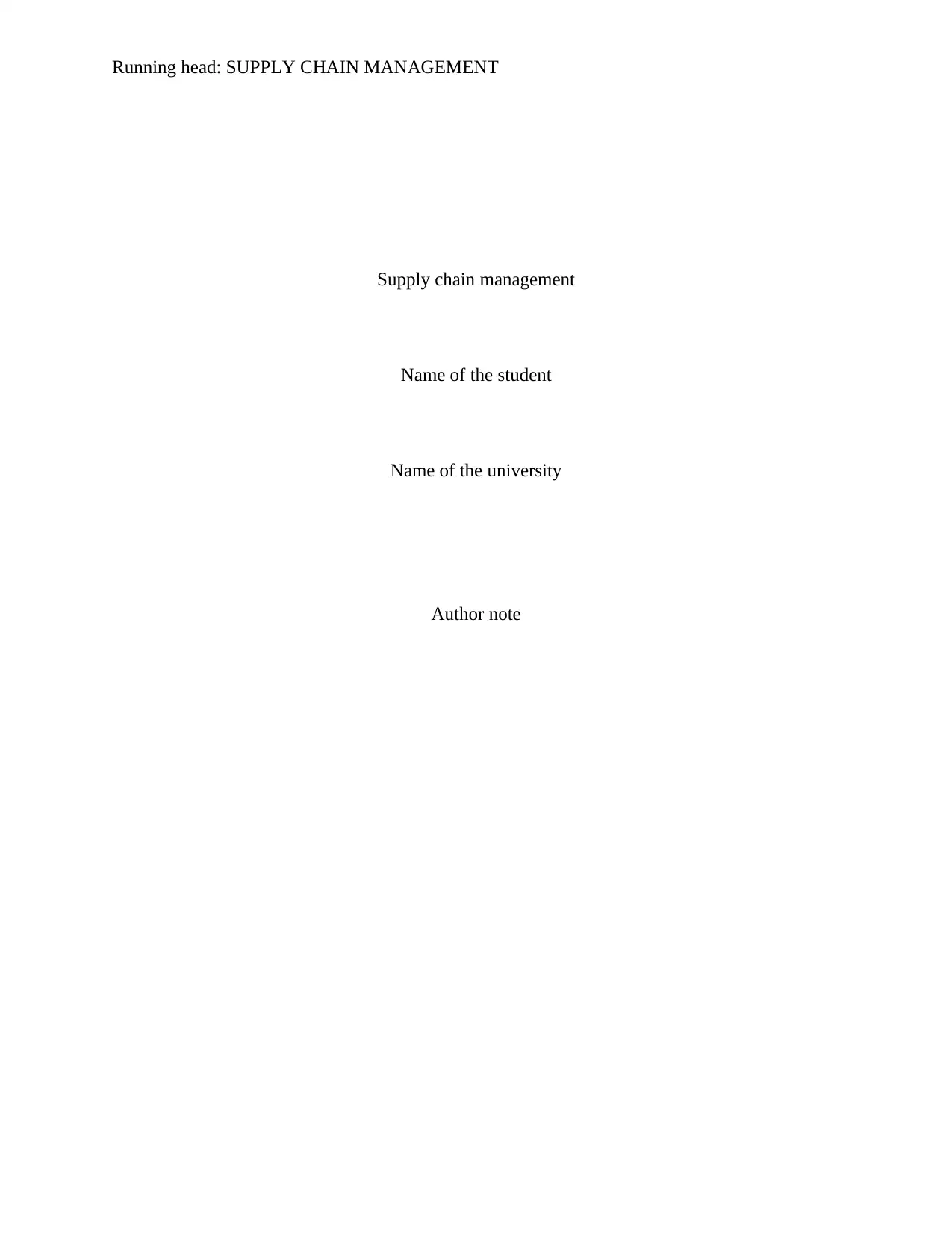
Running head: SUPPLY CHAIN MANAGEMENT
Supply chain management
Name of the student
Name of the university
Author note
Supply chain management
Name of the student
Name of the university
Author note
Secure Best Marks with AI Grader
Need help grading? Try our AI Grader for instant feedback on your assignments.
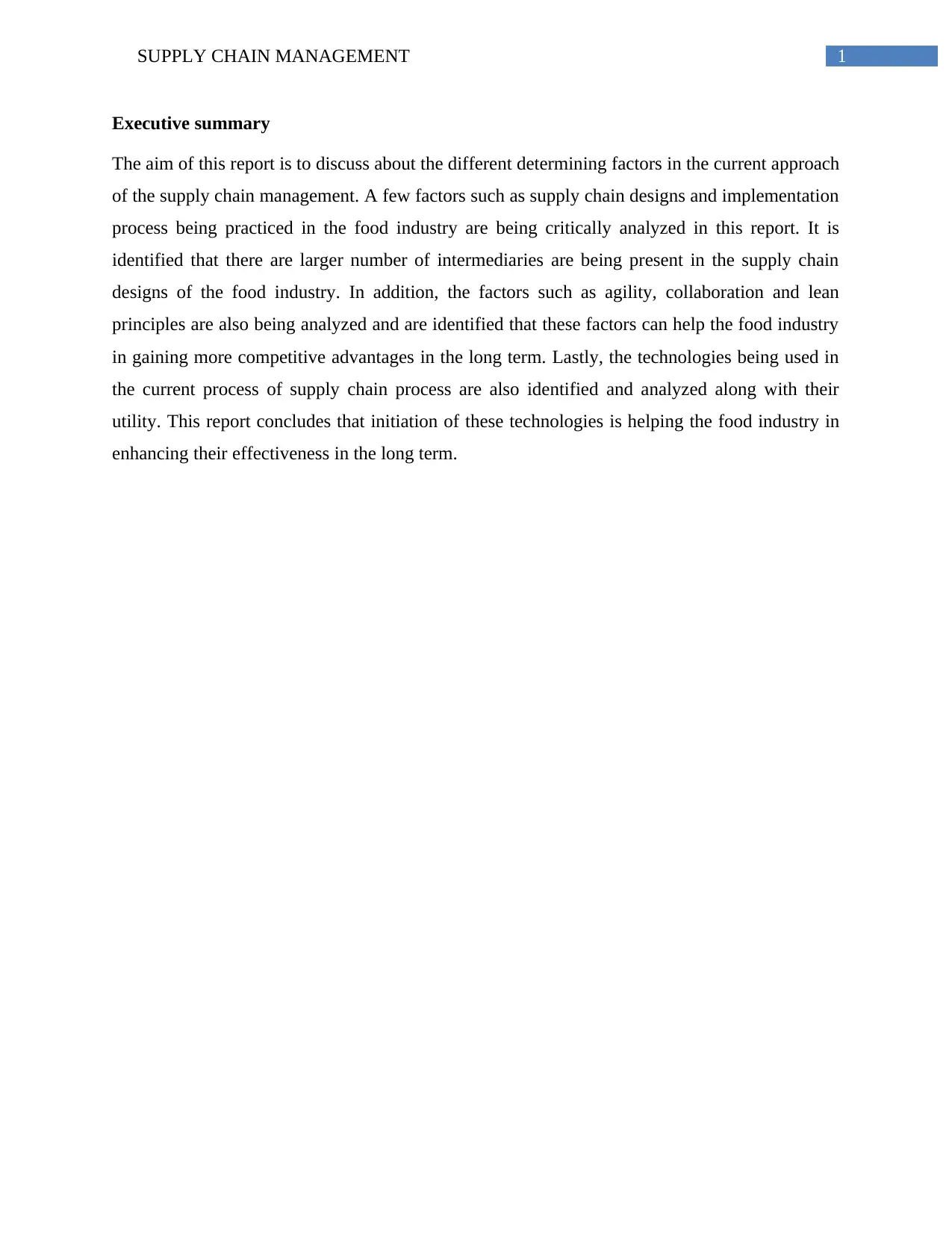
1SUPPLY CHAIN MANAGEMENT
Executive summary
The aim of this report is to discuss about the different determining factors in the current approach
of the supply chain management. A few factors such as supply chain designs and implementation
process being practiced in the food industry are being critically analyzed in this report. It is
identified that there are larger number of intermediaries are being present in the supply chain
designs of the food industry. In addition, the factors such as agility, collaboration and lean
principles are also being analyzed and are identified that these factors can help the food industry
in gaining more competitive advantages in the long term. Lastly, the technologies being used in
the current process of supply chain process are also identified and analyzed along with their
utility. This report concludes that initiation of these technologies is helping the food industry in
enhancing their effectiveness in the long term.
Executive summary
The aim of this report is to discuss about the different determining factors in the current approach
of the supply chain management. A few factors such as supply chain designs and implementation
process being practiced in the food industry are being critically analyzed in this report. It is
identified that there are larger number of intermediaries are being present in the supply chain
designs of the food industry. In addition, the factors such as agility, collaboration and lean
principles are also being analyzed and are identified that these factors can help the food industry
in gaining more competitive advantages in the long term. Lastly, the technologies being used in
the current process of supply chain process are also identified and analyzed along with their
utility. This report concludes that initiation of these technologies is helping the food industry in
enhancing their effectiveness in the long term.
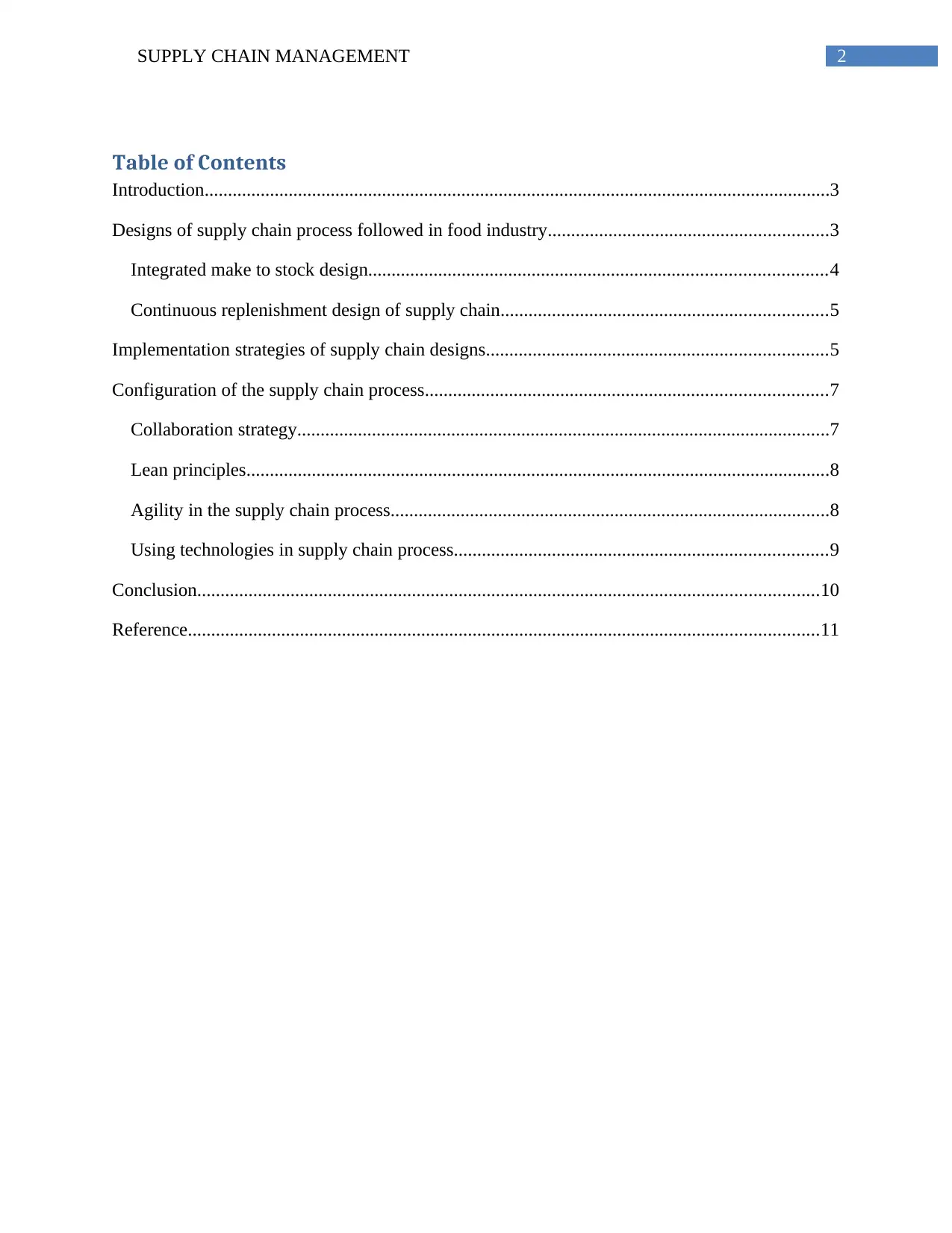
2SUPPLY CHAIN MANAGEMENT
Table of Contents
Introduction......................................................................................................................................3
Designs of supply chain process followed in food industry............................................................3
Integrated make to stock design..................................................................................................4
Continuous replenishment design of supply chain......................................................................5
Implementation strategies of supply chain designs.........................................................................5
Configuration of the supply chain process......................................................................................7
Collaboration strategy..................................................................................................................7
Lean principles.............................................................................................................................8
Agility in the supply chain process..............................................................................................8
Using technologies in supply chain process................................................................................9
Conclusion.....................................................................................................................................10
Reference.......................................................................................................................................11
Table of Contents
Introduction......................................................................................................................................3
Designs of supply chain process followed in food industry............................................................3
Integrated make to stock design..................................................................................................4
Continuous replenishment design of supply chain......................................................................5
Implementation strategies of supply chain designs.........................................................................5
Configuration of the supply chain process......................................................................................7
Collaboration strategy..................................................................................................................7
Lean principles.............................................................................................................................8
Agility in the supply chain process..............................................................................................8
Using technologies in supply chain process................................................................................9
Conclusion.....................................................................................................................................10
Reference.......................................................................................................................................11
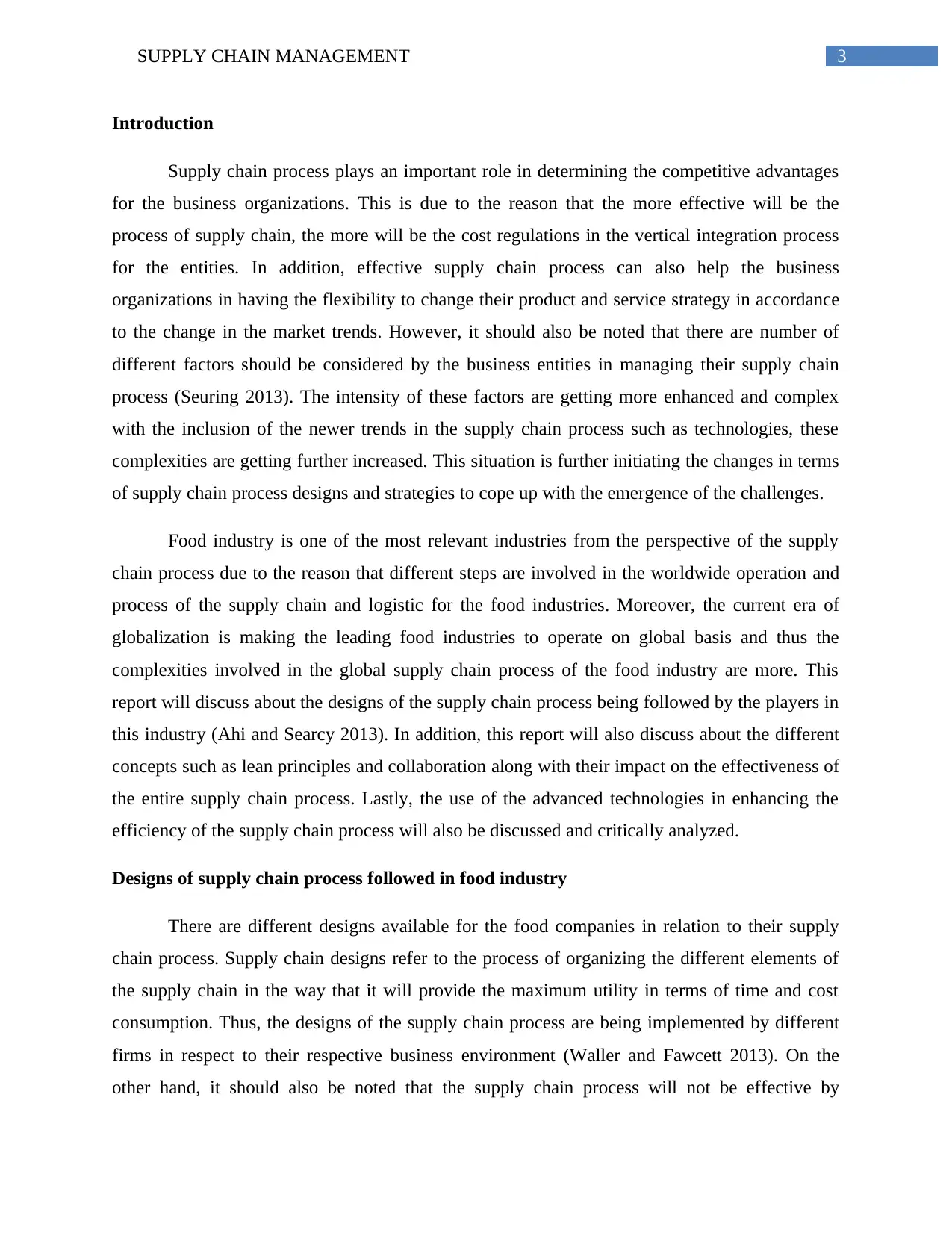
3SUPPLY CHAIN MANAGEMENT
Introduction
Supply chain process plays an important role in determining the competitive advantages
for the business organizations. This is due to the reason that the more effective will be the
process of supply chain, the more will be the cost regulations in the vertical integration process
for the entities. In addition, effective supply chain process can also help the business
organizations in having the flexibility to change their product and service strategy in accordance
to the change in the market trends. However, it should also be noted that there are number of
different factors should be considered by the business entities in managing their supply chain
process (Seuring 2013). The intensity of these factors are getting more enhanced and complex
with the inclusion of the newer trends in the supply chain process such as technologies, these
complexities are getting further increased. This situation is further initiating the changes in terms
of supply chain process designs and strategies to cope up with the emergence of the challenges.
Food industry is one of the most relevant industries from the perspective of the supply
chain process due to the reason that different steps are involved in the worldwide operation and
process of the supply chain and logistic for the food industries. Moreover, the current era of
globalization is making the leading food industries to operate on global basis and thus the
complexities involved in the global supply chain process of the food industry are more. This
report will discuss about the designs of the supply chain process being followed by the players in
this industry (Ahi and Searcy 2013). In addition, this report will also discuss about the different
concepts such as lean principles and collaboration along with their impact on the effectiveness of
the entire supply chain process. Lastly, the use of the advanced technologies in enhancing the
efficiency of the supply chain process will also be discussed and critically analyzed.
Designs of supply chain process followed in food industry
There are different designs available for the food companies in relation to their supply
chain process. Supply chain designs refer to the process of organizing the different elements of
the supply chain in the way that it will provide the maximum utility in terms of time and cost
consumption. Thus, the designs of the supply chain process are being implemented by different
firms in respect to their respective business environment (Waller and Fawcett 2013). On the
other hand, it should also be noted that the supply chain process will not be effective by
Introduction
Supply chain process plays an important role in determining the competitive advantages
for the business organizations. This is due to the reason that the more effective will be the
process of supply chain, the more will be the cost regulations in the vertical integration process
for the entities. In addition, effective supply chain process can also help the business
organizations in having the flexibility to change their product and service strategy in accordance
to the change in the market trends. However, it should also be noted that there are number of
different factors should be considered by the business entities in managing their supply chain
process (Seuring 2013). The intensity of these factors are getting more enhanced and complex
with the inclusion of the newer trends in the supply chain process such as technologies, these
complexities are getting further increased. This situation is further initiating the changes in terms
of supply chain process designs and strategies to cope up with the emergence of the challenges.
Food industry is one of the most relevant industries from the perspective of the supply
chain process due to the reason that different steps are involved in the worldwide operation and
process of the supply chain and logistic for the food industries. Moreover, the current era of
globalization is making the leading food industries to operate on global basis and thus the
complexities involved in the global supply chain process of the food industry are more. This
report will discuss about the designs of the supply chain process being followed by the players in
this industry (Ahi and Searcy 2013). In addition, this report will also discuss about the different
concepts such as lean principles and collaboration along with their impact on the effectiveness of
the entire supply chain process. Lastly, the use of the advanced technologies in enhancing the
efficiency of the supply chain process will also be discussed and critically analyzed.
Designs of supply chain process followed in food industry
There are different designs available for the food companies in relation to their supply
chain process. Supply chain designs refer to the process of organizing the different elements of
the supply chain in the way that it will provide the maximum utility in terms of time and cost
consumption. Thus, the designs of the supply chain process are being implemented by different
firms in respect to their respective business environment (Waller and Fawcett 2013). On the
other hand, it should also be noted that the supply chain process will not be effective by
Secure Best Marks with AI Grader
Need help grading? Try our AI Grader for instant feedback on your assignments.
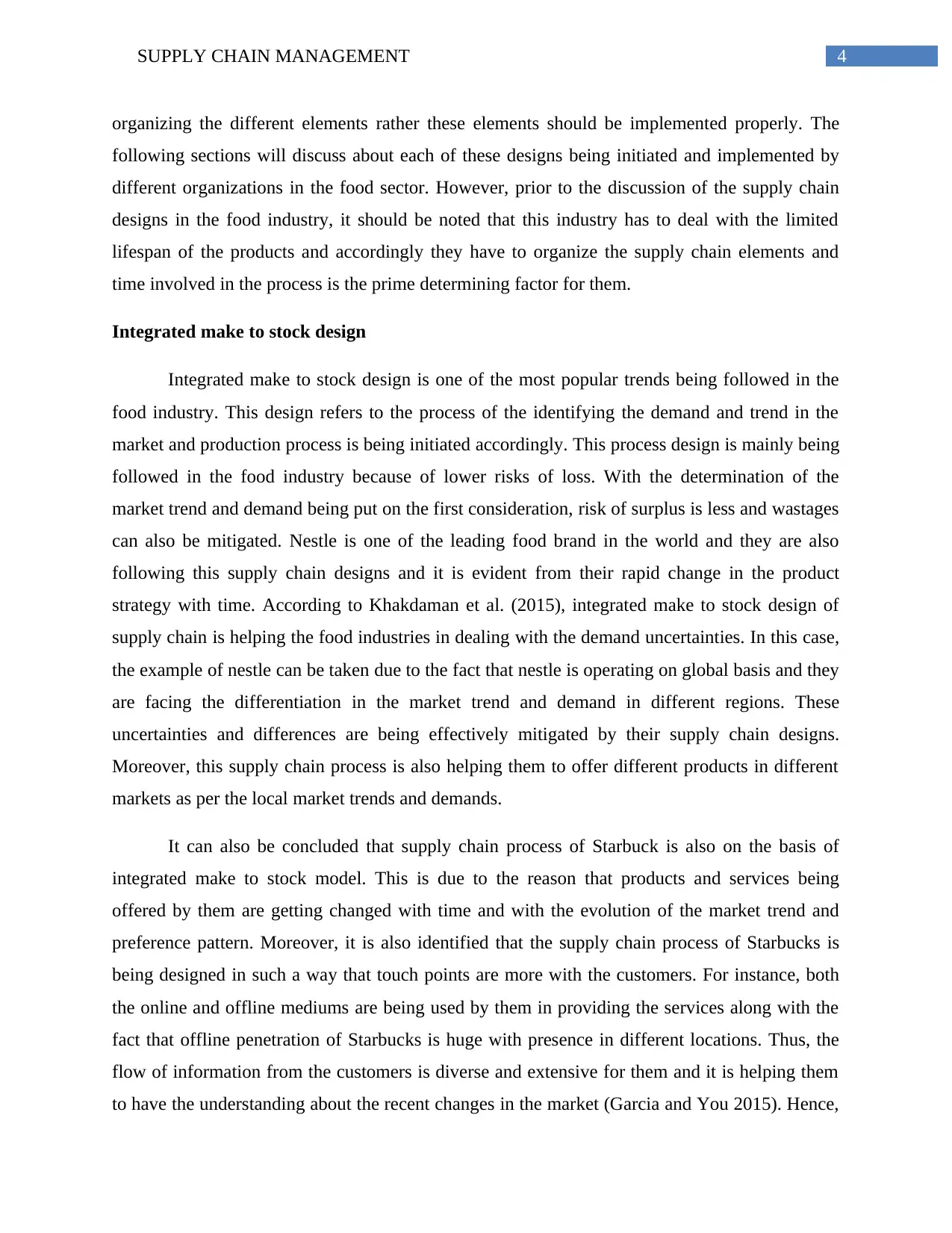
4SUPPLY CHAIN MANAGEMENT
organizing the different elements rather these elements should be implemented properly. The
following sections will discuss about each of these designs being initiated and implemented by
different organizations in the food sector. However, prior to the discussion of the supply chain
designs in the food industry, it should be noted that this industry has to deal with the limited
lifespan of the products and accordingly they have to organize the supply chain elements and
time involved in the process is the prime determining factor for them.
Integrated make to stock design
Integrated make to stock design is one of the most popular trends being followed in the
food industry. This design refers to the process of the identifying the demand and trend in the
market and production process is being initiated accordingly. This process design is mainly being
followed in the food industry because of lower risks of loss. With the determination of the
market trend and demand being put on the first consideration, risk of surplus is less and wastages
can also be mitigated. Nestle is one of the leading food brand in the world and they are also
following this supply chain designs and it is evident from their rapid change in the product
strategy with time. According to Khakdaman et al. (2015), integrated make to stock design of
supply chain is helping the food industries in dealing with the demand uncertainties. In this case,
the example of nestle can be taken due to the fact that nestle is operating on global basis and they
are facing the differentiation in the market trend and demand in different regions. These
uncertainties and differences are being effectively mitigated by their supply chain designs.
Moreover, this supply chain process is also helping them to offer different products in different
markets as per the local market trends and demands.
It can also be concluded that supply chain process of Starbuck is also on the basis of
integrated make to stock model. This is due to the reason that products and services being
offered by them are getting changed with time and with the evolution of the market trend and
preference pattern. Moreover, it is also identified that the supply chain process of Starbucks is
being designed in such a way that touch points are more with the customers. For instance, both
the online and offline mediums are being used by them in providing the services along with the
fact that offline penetration of Starbucks is huge with presence in different locations. Thus, the
flow of information from the customers is diverse and extensive for them and it is helping them
to have the understanding about the recent changes in the market (Garcia and You 2015). Hence,
organizing the different elements rather these elements should be implemented properly. The
following sections will discuss about each of these designs being initiated and implemented by
different organizations in the food sector. However, prior to the discussion of the supply chain
designs in the food industry, it should be noted that this industry has to deal with the limited
lifespan of the products and accordingly they have to organize the supply chain elements and
time involved in the process is the prime determining factor for them.
Integrated make to stock design
Integrated make to stock design is one of the most popular trends being followed in the
food industry. This design refers to the process of the identifying the demand and trend in the
market and production process is being initiated accordingly. This process design is mainly being
followed in the food industry because of lower risks of loss. With the determination of the
market trend and demand being put on the first consideration, risk of surplus is less and wastages
can also be mitigated. Nestle is one of the leading food brand in the world and they are also
following this supply chain designs and it is evident from their rapid change in the product
strategy with time. According to Khakdaman et al. (2015), integrated make to stock design of
supply chain is helping the food industries in dealing with the demand uncertainties. In this case,
the example of nestle can be taken due to the fact that nestle is operating on global basis and they
are facing the differentiation in the market trend and demand in different regions. These
uncertainties and differences are being effectively mitigated by their supply chain designs.
Moreover, this supply chain process is also helping them to offer different products in different
markets as per the local market trends and demands.
It can also be concluded that supply chain process of Starbuck is also on the basis of
integrated make to stock model. This is due to the reason that products and services being
offered by them are getting changed with time and with the evolution of the market trend and
preference pattern. Moreover, it is also identified that the supply chain process of Starbucks is
being designed in such a way that touch points are more with the customers. For instance, both
the online and offline mediums are being used by them in providing the services along with the
fact that offline penetration of Starbucks is huge with presence in different locations. Thus, the
flow of information from the customers is diverse and extensive for them and it is helping them
to have the understanding about the recent changes in the market (Garcia and You 2015). Hence,
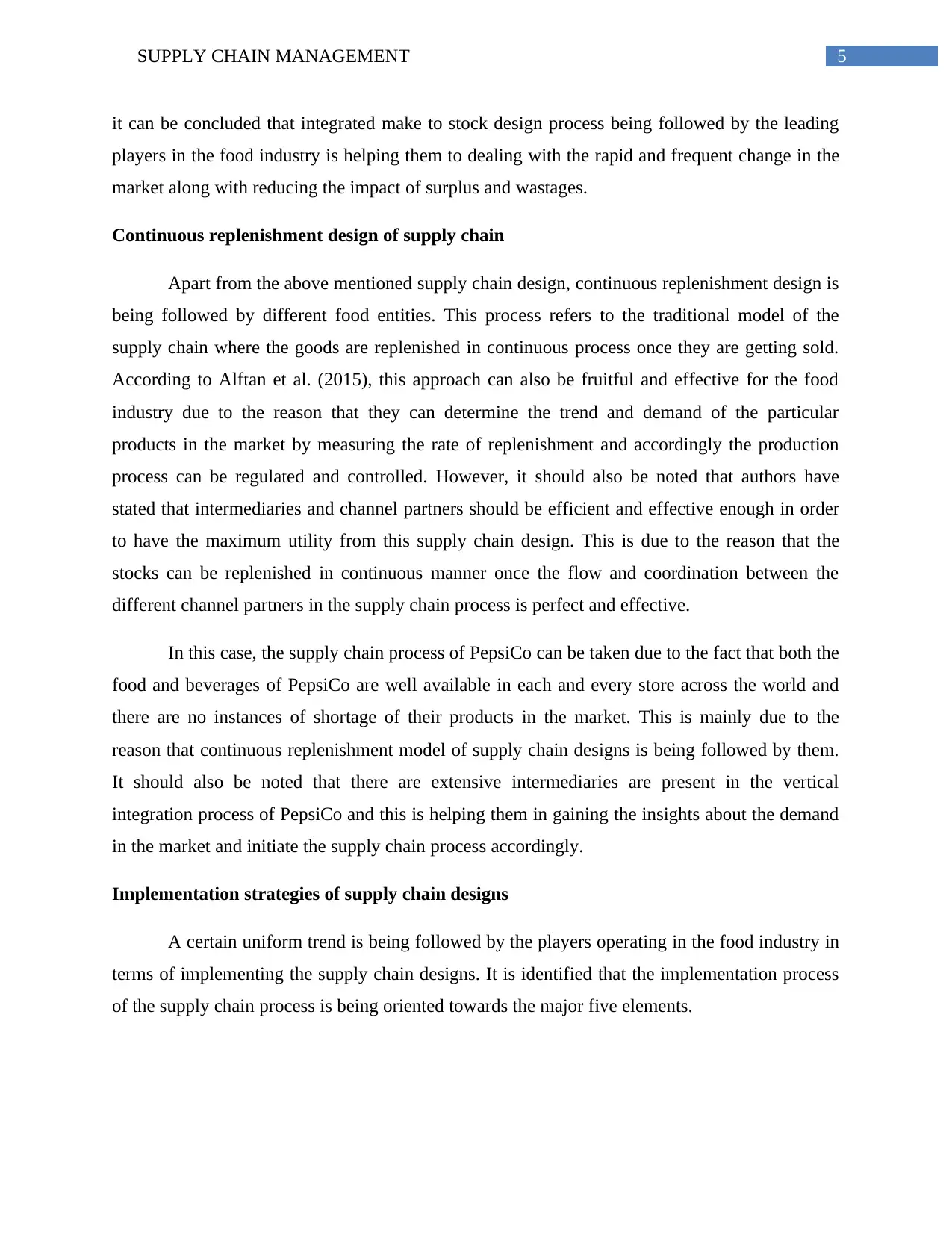
5SUPPLY CHAIN MANAGEMENT
it can be concluded that integrated make to stock design process being followed by the leading
players in the food industry is helping them to dealing with the rapid and frequent change in the
market along with reducing the impact of surplus and wastages.
Continuous replenishment design of supply chain
Apart from the above mentioned supply chain design, continuous replenishment design is
being followed by different food entities. This process refers to the traditional model of the
supply chain where the goods are replenished in continuous process once they are getting sold.
According to Alftan et al. (2015), this approach can also be fruitful and effective for the food
industry due to the reason that they can determine the trend and demand of the particular
products in the market by measuring the rate of replenishment and accordingly the production
process can be regulated and controlled. However, it should also be noted that authors have
stated that intermediaries and channel partners should be efficient and effective enough in order
to have the maximum utility from this supply chain design. This is due to the reason that the
stocks can be replenished in continuous manner once the flow and coordination between the
different channel partners in the supply chain process is perfect and effective.
In this case, the supply chain process of PepsiCo can be taken due to the fact that both the
food and beverages of PepsiCo are well available in each and every store across the world and
there are no instances of shortage of their products in the market. This is mainly due to the
reason that continuous replenishment model of supply chain designs is being followed by them.
It should also be noted that there are extensive intermediaries are present in the vertical
integration process of PepsiCo and this is helping them in gaining the insights about the demand
in the market and initiate the supply chain process accordingly.
Implementation strategies of supply chain designs
A certain uniform trend is being followed by the players operating in the food industry in
terms of implementing the supply chain designs. It is identified that the implementation process
of the supply chain process is being oriented towards the major five elements.
it can be concluded that integrated make to stock design process being followed by the leading
players in the food industry is helping them to dealing with the rapid and frequent change in the
market along with reducing the impact of surplus and wastages.
Continuous replenishment design of supply chain
Apart from the above mentioned supply chain design, continuous replenishment design is
being followed by different food entities. This process refers to the traditional model of the
supply chain where the goods are replenished in continuous process once they are getting sold.
According to Alftan et al. (2015), this approach can also be fruitful and effective for the food
industry due to the reason that they can determine the trend and demand of the particular
products in the market by measuring the rate of replenishment and accordingly the production
process can be regulated and controlled. However, it should also be noted that authors have
stated that intermediaries and channel partners should be efficient and effective enough in order
to have the maximum utility from this supply chain design. This is due to the reason that the
stocks can be replenished in continuous manner once the flow and coordination between the
different channel partners in the supply chain process is perfect and effective.
In this case, the supply chain process of PepsiCo can be taken due to the fact that both the
food and beverages of PepsiCo are well available in each and every store across the world and
there are no instances of shortage of their products in the market. This is mainly due to the
reason that continuous replenishment model of supply chain designs is being followed by them.
It should also be noted that there are extensive intermediaries are present in the vertical
integration process of PepsiCo and this is helping them in gaining the insights about the demand
in the market and initiate the supply chain process accordingly.
Implementation strategies of supply chain designs
A certain uniform trend is being followed by the players operating in the food industry in
terms of implementing the supply chain designs. It is identified that the implementation process
of the supply chain process is being oriented towards the major five elements.
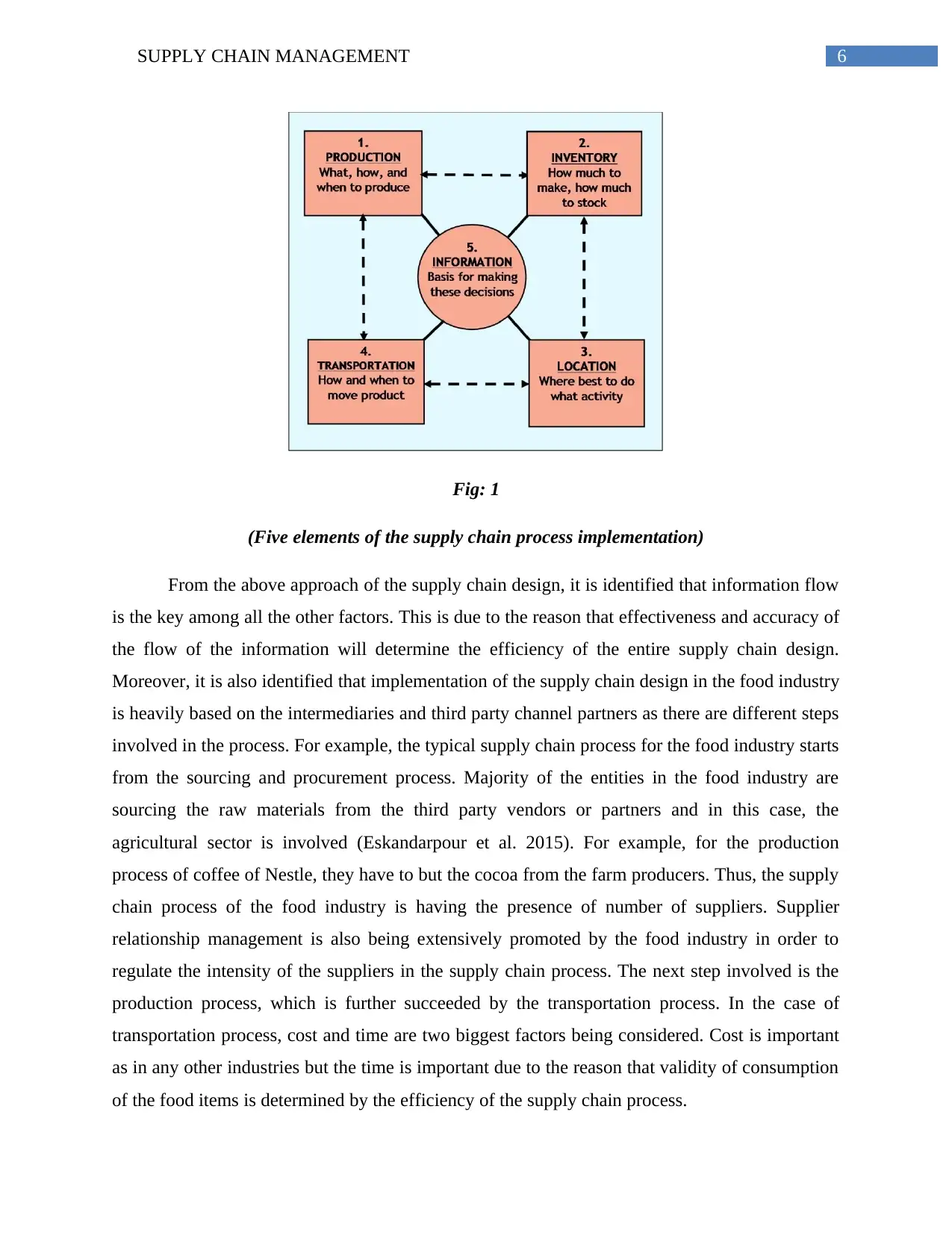
6SUPPLY CHAIN MANAGEMENT
Fig: 1
(Five elements of the supply chain process implementation)
From the above approach of the supply chain design, it is identified that information flow
is the key among all the other factors. This is due to the reason that effectiveness and accuracy of
the flow of the information will determine the efficiency of the entire supply chain design.
Moreover, it is also identified that implementation of the supply chain design in the food industry
is heavily based on the intermediaries and third party channel partners as there are different steps
involved in the process. For example, the typical supply chain process for the food industry starts
from the sourcing and procurement process. Majority of the entities in the food industry are
sourcing the raw materials from the third party vendors or partners and in this case, the
agricultural sector is involved (Eskandarpour et al. 2015). For example, for the production
process of coffee of Nestle, they have to but the cocoa from the farm producers. Thus, the supply
chain process of the food industry is having the presence of number of suppliers. Supplier
relationship management is also being extensively promoted by the food industry in order to
regulate the intensity of the suppliers in the supply chain process. The next step involved is the
production process, which is further succeeded by the transportation process. In the case of
transportation process, cost and time are two biggest factors being considered. Cost is important
as in any other industries but the time is important due to the reason that validity of consumption
of the food items is determined by the efficiency of the supply chain process.
Fig: 1
(Five elements of the supply chain process implementation)
From the above approach of the supply chain design, it is identified that information flow
is the key among all the other factors. This is due to the reason that effectiveness and accuracy of
the flow of the information will determine the efficiency of the entire supply chain design.
Moreover, it is also identified that implementation of the supply chain design in the food industry
is heavily based on the intermediaries and third party channel partners as there are different steps
involved in the process. For example, the typical supply chain process for the food industry starts
from the sourcing and procurement process. Majority of the entities in the food industry are
sourcing the raw materials from the third party vendors or partners and in this case, the
agricultural sector is involved (Eskandarpour et al. 2015). For example, for the production
process of coffee of Nestle, they have to but the cocoa from the farm producers. Thus, the supply
chain process of the food industry is having the presence of number of suppliers. Supplier
relationship management is also being extensively promoted by the food industry in order to
regulate the intensity of the suppliers in the supply chain process. The next step involved is the
production process, which is further succeeded by the transportation process. In the case of
transportation process, cost and time are two biggest factors being considered. Cost is important
as in any other industries but the time is important due to the reason that validity of consumption
of the food items is determined by the efficiency of the supply chain process.
Paraphrase This Document
Need a fresh take? Get an instant paraphrase of this document with our AI Paraphraser
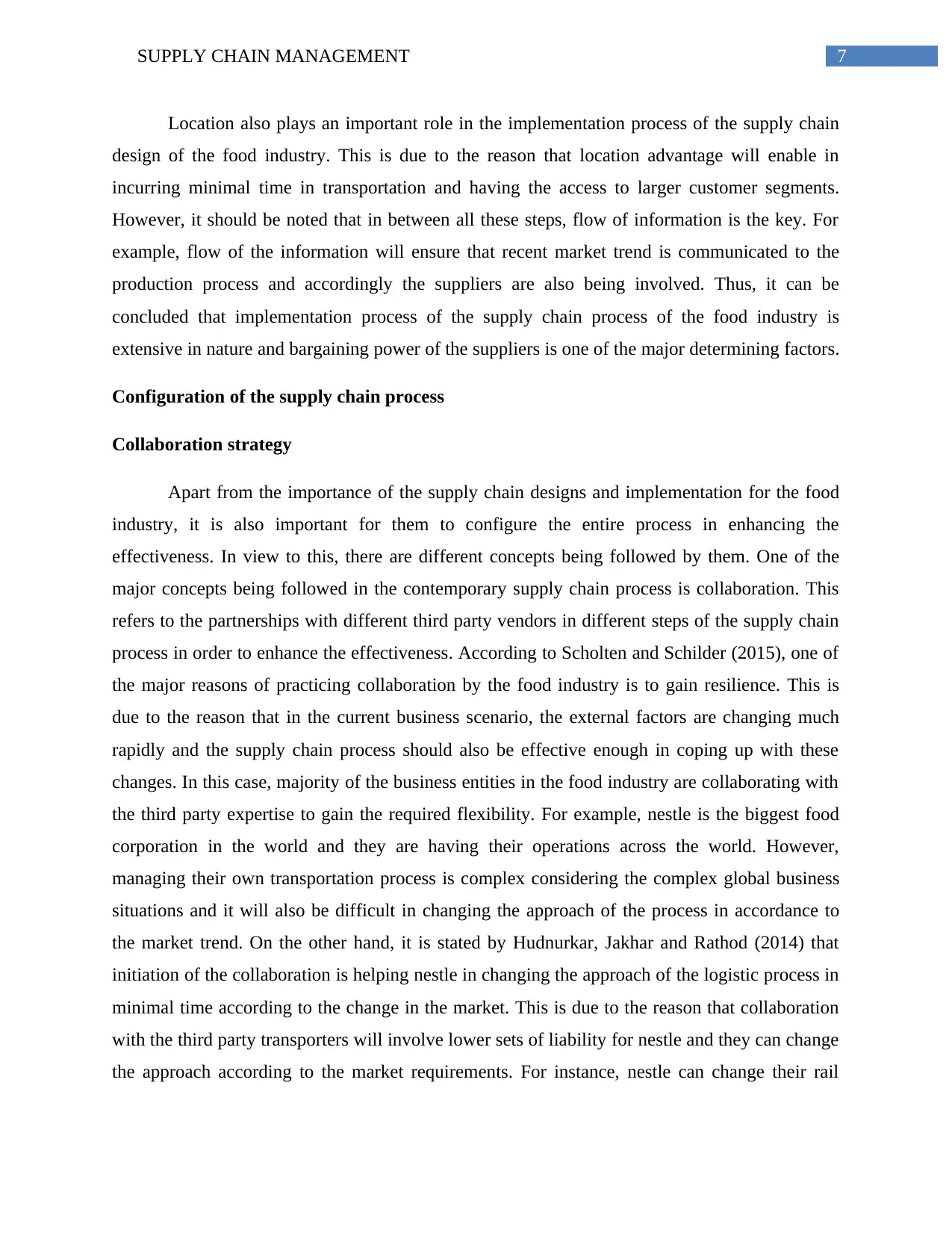
7SUPPLY CHAIN MANAGEMENT
Location also plays an important role in the implementation process of the supply chain
design of the food industry. This is due to the reason that location advantage will enable in
incurring minimal time in transportation and having the access to larger customer segments.
However, it should be noted that in between all these steps, flow of information is the key. For
example, flow of the information will ensure that recent market trend is communicated to the
production process and accordingly the suppliers are also being involved. Thus, it can be
concluded that implementation process of the supply chain process of the food industry is
extensive in nature and bargaining power of the suppliers is one of the major determining factors.
Configuration of the supply chain process
Collaboration strategy
Apart from the importance of the supply chain designs and implementation for the food
industry, it is also important for them to configure the entire process in enhancing the
effectiveness. In view to this, there are different concepts being followed by them. One of the
major concepts being followed in the contemporary supply chain process is collaboration. This
refers to the partnerships with different third party vendors in different steps of the supply chain
process in order to enhance the effectiveness. According to Scholten and Schilder (2015), one of
the major reasons of practicing collaboration by the food industry is to gain resilience. This is
due to the reason that in the current business scenario, the external factors are changing much
rapidly and the supply chain process should also be effective enough in coping up with these
changes. In this case, majority of the business entities in the food industry are collaborating with
the third party expertise to gain the required flexibility. For example, nestle is the biggest food
corporation in the world and they are having their operations across the world. However,
managing their own transportation process is complex considering the complex global business
situations and it will also be difficult in changing the approach of the process in accordance to
the market trend. On the other hand, it is stated by Hudnurkar, Jakhar and Rathod (2014) that
initiation of the collaboration is helping nestle in changing the approach of the logistic process in
minimal time according to the change in the market. This is due to the reason that collaboration
with the third party transporters will involve lower sets of liability for nestle and they can change
the approach according to the market requirements. For instance, nestle can change their rail
Location also plays an important role in the implementation process of the supply chain
design of the food industry. This is due to the reason that location advantage will enable in
incurring minimal time in transportation and having the access to larger customer segments.
However, it should be noted that in between all these steps, flow of information is the key. For
example, flow of the information will ensure that recent market trend is communicated to the
production process and accordingly the suppliers are also being involved. Thus, it can be
concluded that implementation process of the supply chain process of the food industry is
extensive in nature and bargaining power of the suppliers is one of the major determining factors.
Configuration of the supply chain process
Collaboration strategy
Apart from the importance of the supply chain designs and implementation for the food
industry, it is also important for them to configure the entire process in enhancing the
effectiveness. In view to this, there are different concepts being followed by them. One of the
major concepts being followed in the contemporary supply chain process is collaboration. This
refers to the partnerships with different third party vendors in different steps of the supply chain
process in order to enhance the effectiveness. According to Scholten and Schilder (2015), one of
the major reasons of practicing collaboration by the food industry is to gain resilience. This is
due to the reason that in the current business scenario, the external factors are changing much
rapidly and the supply chain process should also be effective enough in coping up with these
changes. In this case, majority of the business entities in the food industry are collaborating with
the third party expertise to gain the required flexibility. For example, nestle is the biggest food
corporation in the world and they are having their operations across the world. However,
managing their own transportation process is complex considering the complex global business
situations and it will also be difficult in changing the approach of the process in accordance to
the market trend. On the other hand, it is stated by Hudnurkar, Jakhar and Rathod (2014) that
initiation of the collaboration is helping nestle in changing the approach of the logistic process in
minimal time according to the change in the market. This is due to the reason that collaboration
with the third party transporters will involve lower sets of liability for nestle and they can change
the approach according to the market requirements. For instance, nestle can change their rail
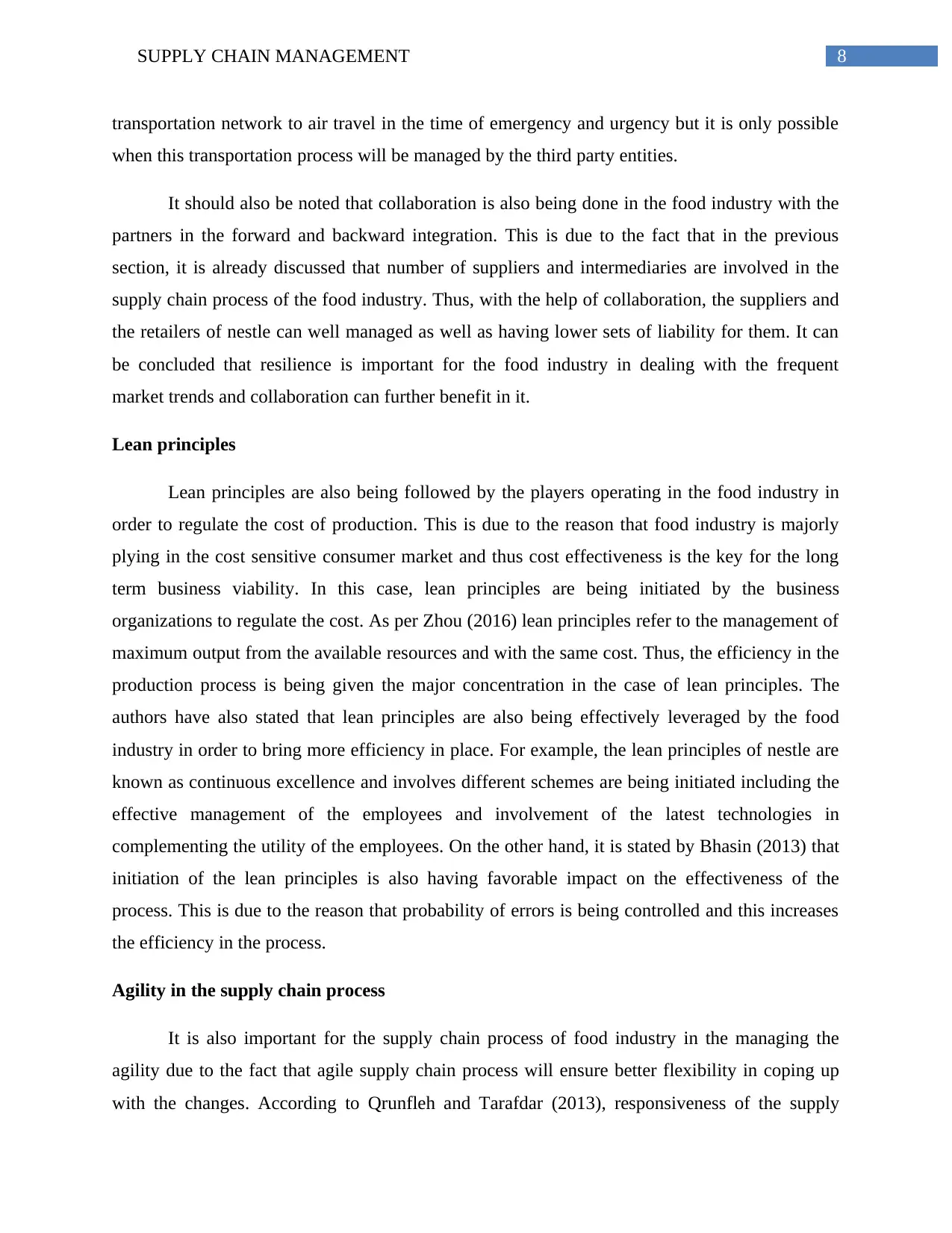
8SUPPLY CHAIN MANAGEMENT
transportation network to air travel in the time of emergency and urgency but it is only possible
when this transportation process will be managed by the third party entities.
It should also be noted that collaboration is also being done in the food industry with the
partners in the forward and backward integration. This is due to the fact that in the previous
section, it is already discussed that number of suppliers and intermediaries are involved in the
supply chain process of the food industry. Thus, with the help of collaboration, the suppliers and
the retailers of nestle can well managed as well as having lower sets of liability for them. It can
be concluded that resilience is important for the food industry in dealing with the frequent
market trends and collaboration can further benefit in it.
Lean principles
Lean principles are also being followed by the players operating in the food industry in
order to regulate the cost of production. This is due to the reason that food industry is majorly
plying in the cost sensitive consumer market and thus cost effectiveness is the key for the long
term business viability. In this case, lean principles are being initiated by the business
organizations to regulate the cost. As per Zhou (2016) lean principles refer to the management of
maximum output from the available resources and with the same cost. Thus, the efficiency in the
production process is being given the major concentration in the case of lean principles. The
authors have also stated that lean principles are also being effectively leveraged by the food
industry in order to bring more efficiency in place. For example, the lean principles of nestle are
known as continuous excellence and involves different schemes are being initiated including the
effective management of the employees and involvement of the latest technologies in
complementing the utility of the employees. On the other hand, it is stated by Bhasin (2013) that
initiation of the lean principles is also having favorable impact on the effectiveness of the
process. This is due to the reason that probability of errors is being controlled and this increases
the efficiency in the process.
Agility in the supply chain process
It is also important for the supply chain process of food industry in the managing the
agility due to the fact that agile supply chain process will ensure better flexibility in coping up
with the changes. According to Qrunfleh and Tarafdar (2013), responsiveness of the supply
transportation network to air travel in the time of emergency and urgency but it is only possible
when this transportation process will be managed by the third party entities.
It should also be noted that collaboration is also being done in the food industry with the
partners in the forward and backward integration. This is due to the fact that in the previous
section, it is already discussed that number of suppliers and intermediaries are involved in the
supply chain process of the food industry. Thus, with the help of collaboration, the suppliers and
the retailers of nestle can well managed as well as having lower sets of liability for them. It can
be concluded that resilience is important for the food industry in dealing with the frequent
market trends and collaboration can further benefit in it.
Lean principles
Lean principles are also being followed by the players operating in the food industry in
order to regulate the cost of production. This is due to the reason that food industry is majorly
plying in the cost sensitive consumer market and thus cost effectiveness is the key for the long
term business viability. In this case, lean principles are being initiated by the business
organizations to regulate the cost. As per Zhou (2016) lean principles refer to the management of
maximum output from the available resources and with the same cost. Thus, the efficiency in the
production process is being given the major concentration in the case of lean principles. The
authors have also stated that lean principles are also being effectively leveraged by the food
industry in order to bring more efficiency in place. For example, the lean principles of nestle are
known as continuous excellence and involves different schemes are being initiated including the
effective management of the employees and involvement of the latest technologies in
complementing the utility of the employees. On the other hand, it is stated by Bhasin (2013) that
initiation of the lean principles is also having favorable impact on the effectiveness of the
process. This is due to the reason that probability of errors is being controlled and this increases
the efficiency in the process.
Agility in the supply chain process
It is also important for the supply chain process of food industry in the managing the
agility due to the fact that agile supply chain process will ensure better flexibility in coping up
with the changes. According to Qrunfleh and Tarafdar (2013), responsiveness of the supply
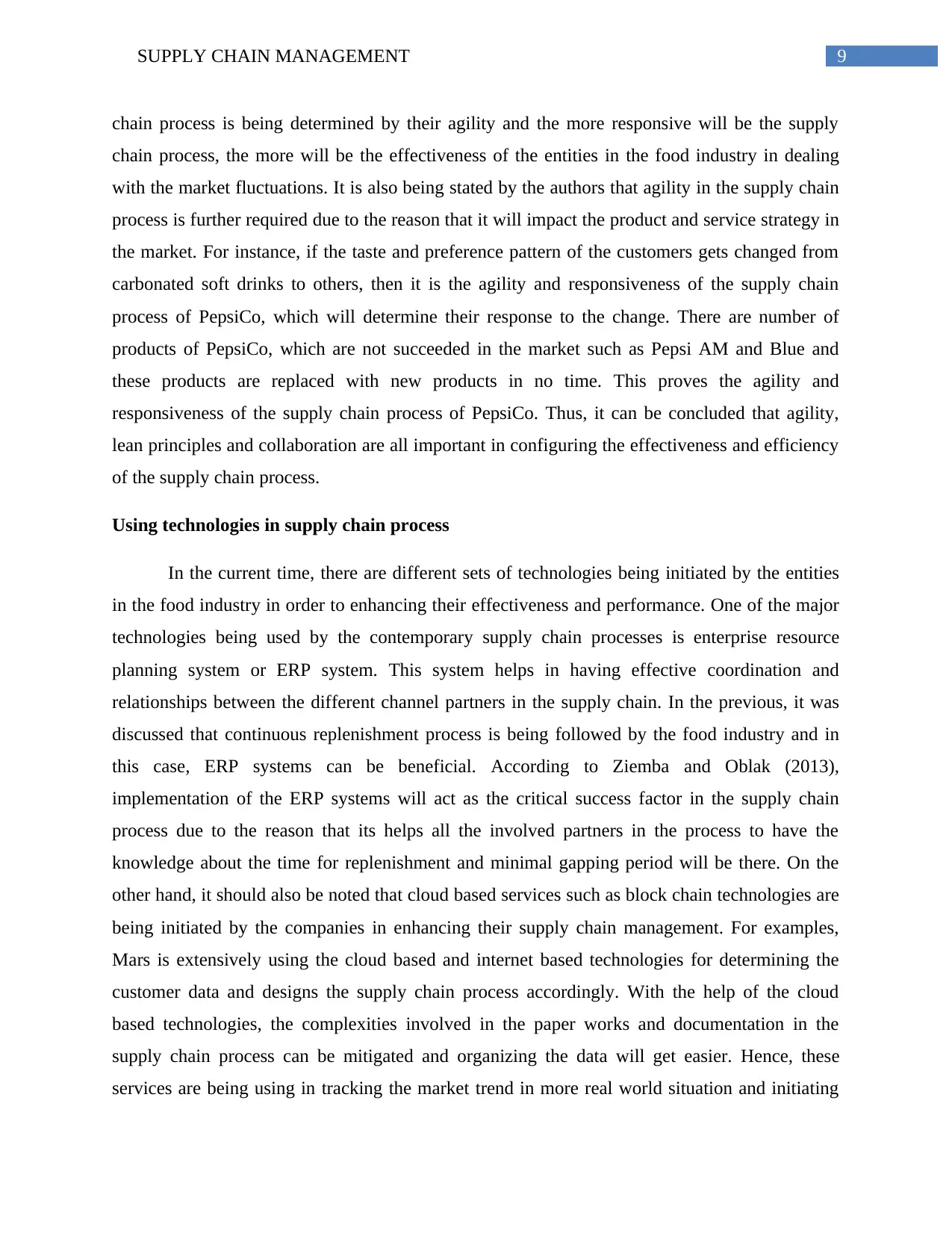
9SUPPLY CHAIN MANAGEMENT
chain process is being determined by their agility and the more responsive will be the supply
chain process, the more will be the effectiveness of the entities in the food industry in dealing
with the market fluctuations. It is also being stated by the authors that agility in the supply chain
process is further required due to the reason that it will impact the product and service strategy in
the market. For instance, if the taste and preference pattern of the customers gets changed from
carbonated soft drinks to others, then it is the agility and responsiveness of the supply chain
process of PepsiCo, which will determine their response to the change. There are number of
products of PepsiCo, which are not succeeded in the market such as Pepsi AM and Blue and
these products are replaced with new products in no time. This proves the agility and
responsiveness of the supply chain process of PepsiCo. Thus, it can be concluded that agility,
lean principles and collaboration are all important in configuring the effectiveness and efficiency
of the supply chain process.
Using technologies in supply chain process
In the current time, there are different sets of technologies being initiated by the entities
in the food industry in order to enhancing their effectiveness and performance. One of the major
technologies being used by the contemporary supply chain processes is enterprise resource
planning system or ERP system. This system helps in having effective coordination and
relationships between the different channel partners in the supply chain. In the previous, it was
discussed that continuous replenishment process is being followed by the food industry and in
this case, ERP systems can be beneficial. According to Ziemba and Oblak (2013),
implementation of the ERP systems will act as the critical success factor in the supply chain
process due to the reason that its helps all the involved partners in the process to have the
knowledge about the time for replenishment and minimal gapping period will be there. On the
other hand, it should also be noted that cloud based services such as block chain technologies are
being initiated by the companies in enhancing their supply chain management. For examples,
Mars is extensively using the cloud based and internet based technologies for determining the
customer data and designs the supply chain process accordingly. With the help of the cloud
based technologies, the complexities involved in the paper works and documentation in the
supply chain process can be mitigated and organizing the data will get easier. Hence, these
services are being using in tracking the market trend in more real world situation and initiating
chain process is being determined by their agility and the more responsive will be the supply
chain process, the more will be the effectiveness of the entities in the food industry in dealing
with the market fluctuations. It is also being stated by the authors that agility in the supply chain
process is further required due to the reason that it will impact the product and service strategy in
the market. For instance, if the taste and preference pattern of the customers gets changed from
carbonated soft drinks to others, then it is the agility and responsiveness of the supply chain
process of PepsiCo, which will determine their response to the change. There are number of
products of PepsiCo, which are not succeeded in the market such as Pepsi AM and Blue and
these products are replaced with new products in no time. This proves the agility and
responsiveness of the supply chain process of PepsiCo. Thus, it can be concluded that agility,
lean principles and collaboration are all important in configuring the effectiveness and efficiency
of the supply chain process.
Using technologies in supply chain process
In the current time, there are different sets of technologies being initiated by the entities
in the food industry in order to enhancing their effectiveness and performance. One of the major
technologies being used by the contemporary supply chain processes is enterprise resource
planning system or ERP system. This system helps in having effective coordination and
relationships between the different channel partners in the supply chain. In the previous, it was
discussed that continuous replenishment process is being followed by the food industry and in
this case, ERP systems can be beneficial. According to Ziemba and Oblak (2013),
implementation of the ERP systems will act as the critical success factor in the supply chain
process due to the reason that its helps all the involved partners in the process to have the
knowledge about the time for replenishment and minimal gapping period will be there. On the
other hand, it should also be noted that cloud based services such as block chain technologies are
being initiated by the companies in enhancing their supply chain management. For examples,
Mars is extensively using the cloud based and internet based technologies for determining the
customer data and designs the supply chain process accordingly. With the help of the cloud
based technologies, the complexities involved in the paper works and documentation in the
supply chain process can be mitigated and organizing the data will get easier. Hence, these
services are being using in tracking the market trend in more real world situation and initiating
Secure Best Marks with AI Grader
Need help grading? Try our AI Grader for instant feedback on your assignments.
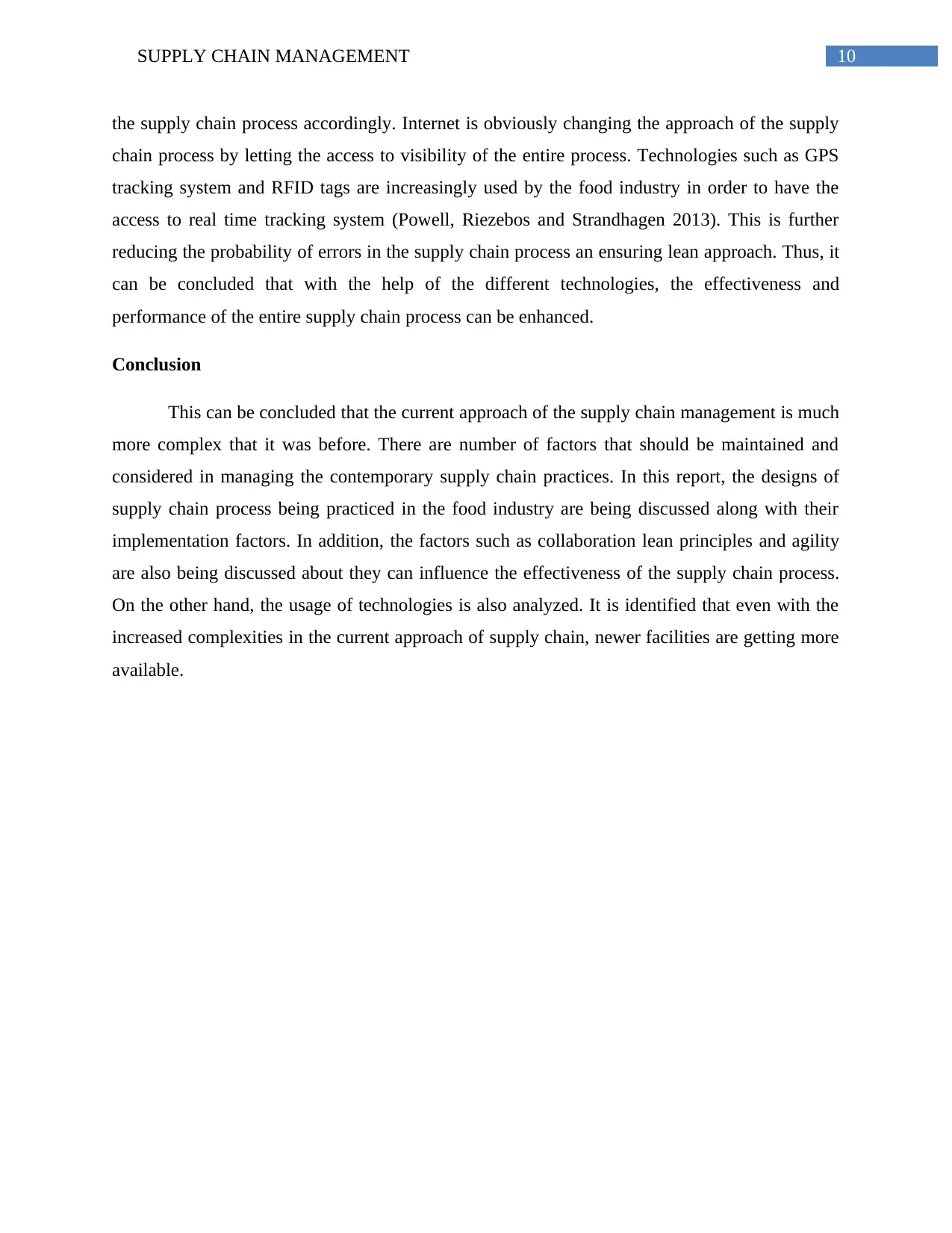
10SUPPLY CHAIN MANAGEMENT
the supply chain process accordingly. Internet is obviously changing the approach of the supply
chain process by letting the access to visibility of the entire process. Technologies such as GPS
tracking system and RFID tags are increasingly used by the food industry in order to have the
access to real time tracking system (Powell, Riezebos and Strandhagen 2013). This is further
reducing the probability of errors in the supply chain process an ensuring lean approach. Thus, it
can be concluded that with the help of the different technologies, the effectiveness and
performance of the entire supply chain process can be enhanced.
Conclusion
This can be concluded that the current approach of the supply chain management is much
more complex that it was before. There are number of factors that should be maintained and
considered in managing the contemporary supply chain practices. In this report, the designs of
supply chain process being practiced in the food industry are being discussed along with their
implementation factors. In addition, the factors such as collaboration lean principles and agility
are also being discussed about they can influence the effectiveness of the supply chain process.
On the other hand, the usage of technologies is also analyzed. It is identified that even with the
increased complexities in the current approach of supply chain, newer facilities are getting more
available.
the supply chain process accordingly. Internet is obviously changing the approach of the supply
chain process by letting the access to visibility of the entire process. Technologies such as GPS
tracking system and RFID tags are increasingly used by the food industry in order to have the
access to real time tracking system (Powell, Riezebos and Strandhagen 2013). This is further
reducing the probability of errors in the supply chain process an ensuring lean approach. Thus, it
can be concluded that with the help of the different technologies, the effectiveness and
performance of the entire supply chain process can be enhanced.
Conclusion
This can be concluded that the current approach of the supply chain management is much
more complex that it was before. There are number of factors that should be maintained and
considered in managing the contemporary supply chain practices. In this report, the designs of
supply chain process being practiced in the food industry are being discussed along with their
implementation factors. In addition, the factors such as collaboration lean principles and agility
are also being discussed about they can influence the effectiveness of the supply chain process.
On the other hand, the usage of technologies is also analyzed. It is identified that even with the
increased complexities in the current approach of supply chain, newer facilities are getting more
available.
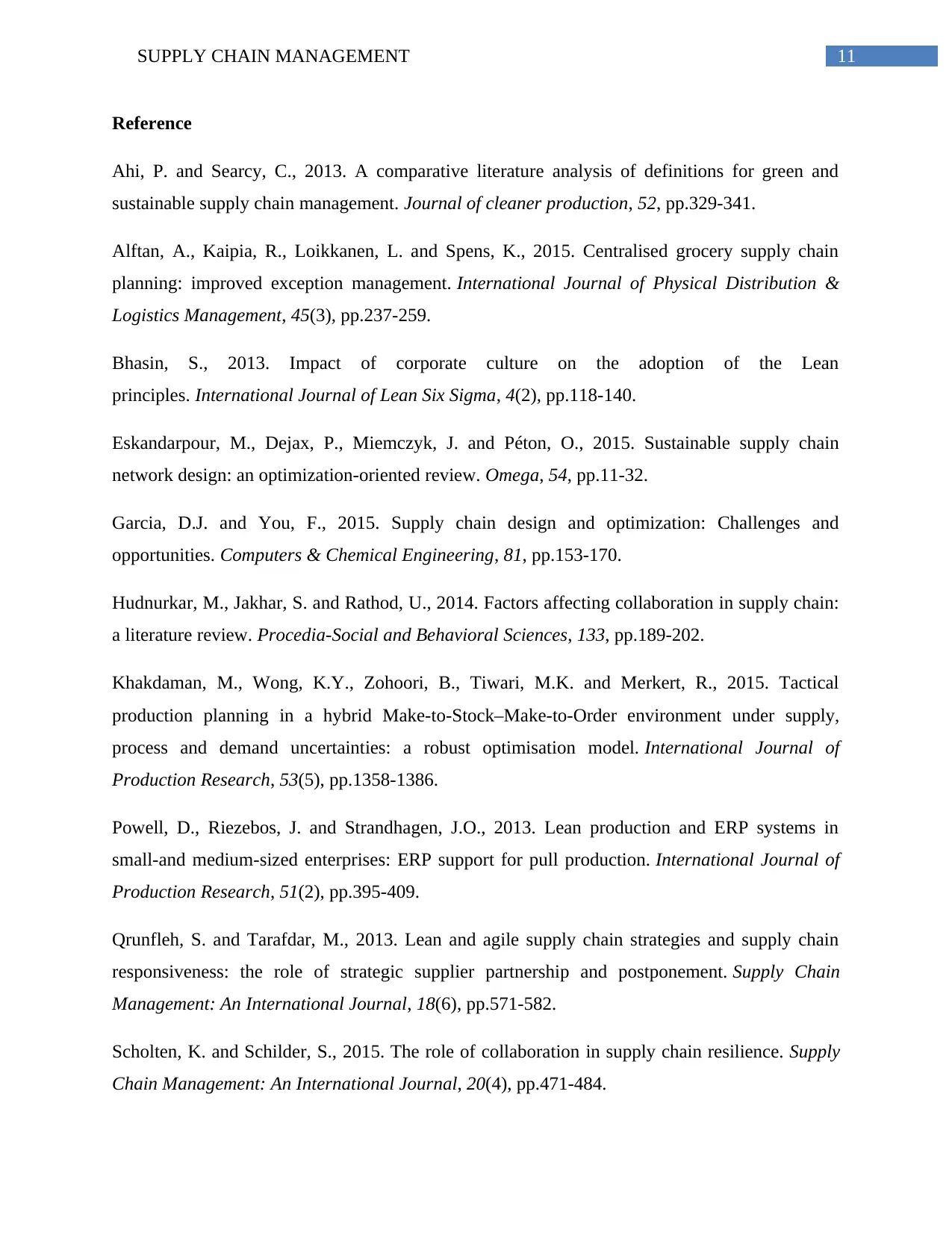
11SUPPLY CHAIN MANAGEMENT
Reference
Ahi, P. and Searcy, C., 2013. A comparative literature analysis of definitions for green and
sustainable supply chain management. Journal of cleaner production, 52, pp.329-341.
Alftan, A., Kaipia, R., Loikkanen, L. and Spens, K., 2015. Centralised grocery supply chain
planning: improved exception management. International Journal of Physical Distribution &
Logistics Management, 45(3), pp.237-259.
Bhasin, S., 2013. Impact of corporate culture on the adoption of the Lean
principles. International Journal of Lean Six Sigma, 4(2), pp.118-140.
Eskandarpour, M., Dejax, P., Miemczyk, J. and Péton, O., 2015. Sustainable supply chain
network design: an optimization-oriented review. Omega, 54, pp.11-32.
Garcia, D.J. and You, F., 2015. Supply chain design and optimization: Challenges and
opportunities. Computers & Chemical Engineering, 81, pp.153-170.
Hudnurkar, M., Jakhar, S. and Rathod, U., 2014. Factors affecting collaboration in supply chain:
a literature review. Procedia-Social and Behavioral Sciences, 133, pp.189-202.
Khakdaman, M., Wong, K.Y., Zohoori, B., Tiwari, M.K. and Merkert, R., 2015. Tactical
production planning in a hybrid Make-to-Stock–Make-to-Order environment under supply,
process and demand uncertainties: a robust optimisation model. International Journal of
Production Research, 53(5), pp.1358-1386.
Powell, D., Riezebos, J. and Strandhagen, J.O., 2013. Lean production and ERP systems in
small-and medium-sized enterprises: ERP support for pull production. International Journal of
Production Research, 51(2), pp.395-409.
Qrunfleh, S. and Tarafdar, M., 2013. Lean and agile supply chain strategies and supply chain
responsiveness: the role of strategic supplier partnership and postponement. Supply Chain
Management: An International Journal, 18(6), pp.571-582.
Scholten, K. and Schilder, S., 2015. The role of collaboration in supply chain resilience. Supply
Chain Management: An International Journal, 20(4), pp.471-484.
Reference
Ahi, P. and Searcy, C., 2013. A comparative literature analysis of definitions for green and
sustainable supply chain management. Journal of cleaner production, 52, pp.329-341.
Alftan, A., Kaipia, R., Loikkanen, L. and Spens, K., 2015. Centralised grocery supply chain
planning: improved exception management. International Journal of Physical Distribution &
Logistics Management, 45(3), pp.237-259.
Bhasin, S., 2013. Impact of corporate culture on the adoption of the Lean
principles. International Journal of Lean Six Sigma, 4(2), pp.118-140.
Eskandarpour, M., Dejax, P., Miemczyk, J. and Péton, O., 2015. Sustainable supply chain
network design: an optimization-oriented review. Omega, 54, pp.11-32.
Garcia, D.J. and You, F., 2015. Supply chain design and optimization: Challenges and
opportunities. Computers & Chemical Engineering, 81, pp.153-170.
Hudnurkar, M., Jakhar, S. and Rathod, U., 2014. Factors affecting collaboration in supply chain:
a literature review. Procedia-Social and Behavioral Sciences, 133, pp.189-202.
Khakdaman, M., Wong, K.Y., Zohoori, B., Tiwari, M.K. and Merkert, R., 2015. Tactical
production planning in a hybrid Make-to-Stock–Make-to-Order environment under supply,
process and demand uncertainties: a robust optimisation model. International Journal of
Production Research, 53(5), pp.1358-1386.
Powell, D., Riezebos, J. and Strandhagen, J.O., 2013. Lean production and ERP systems in
small-and medium-sized enterprises: ERP support for pull production. International Journal of
Production Research, 51(2), pp.395-409.
Qrunfleh, S. and Tarafdar, M., 2013. Lean and agile supply chain strategies and supply chain
responsiveness: the role of strategic supplier partnership and postponement. Supply Chain
Management: An International Journal, 18(6), pp.571-582.
Scholten, K. and Schilder, S., 2015. The role of collaboration in supply chain resilience. Supply
Chain Management: An International Journal, 20(4), pp.471-484.
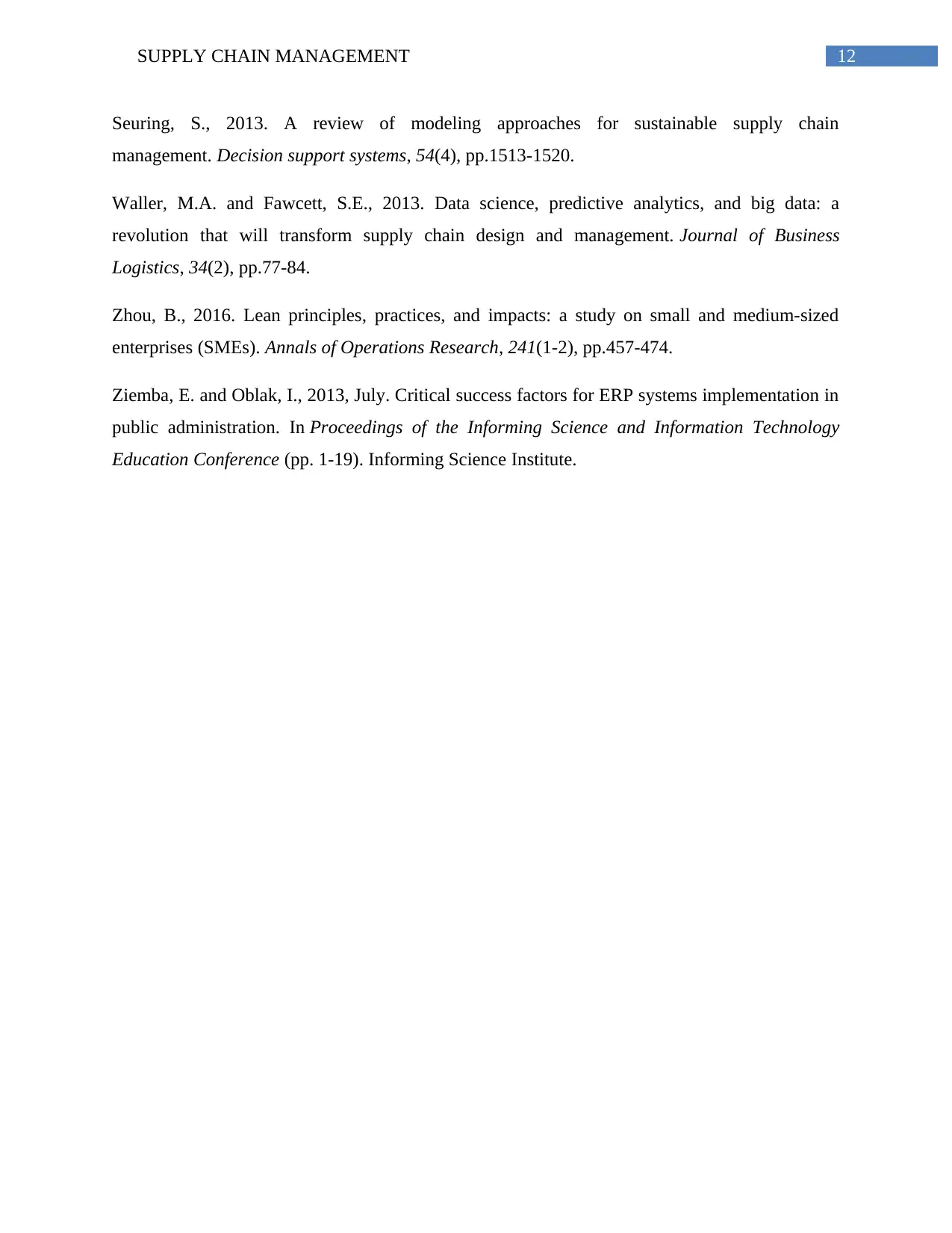
12SUPPLY CHAIN MANAGEMENT
Seuring, S., 2013. A review of modeling approaches for sustainable supply chain
management. Decision support systems, 54(4), pp.1513-1520.
Waller, M.A. and Fawcett, S.E., 2013. Data science, predictive analytics, and big data: a
revolution that will transform supply chain design and management. Journal of Business
Logistics, 34(2), pp.77-84.
Zhou, B., 2016. Lean principles, practices, and impacts: a study on small and medium-sized
enterprises (SMEs). Annals of Operations Research, 241(1-2), pp.457-474.
Ziemba, E. and Oblak, I., 2013, July. Critical success factors for ERP systems implementation in
public administration. In Proceedings of the Informing Science and Information Technology
Education Conference (pp. 1-19). Informing Science Institute.
Seuring, S., 2013. A review of modeling approaches for sustainable supply chain
management. Decision support systems, 54(4), pp.1513-1520.
Waller, M.A. and Fawcett, S.E., 2013. Data science, predictive analytics, and big data: a
revolution that will transform supply chain design and management. Journal of Business
Logistics, 34(2), pp.77-84.
Zhou, B., 2016. Lean principles, practices, and impacts: a study on small and medium-sized
enterprises (SMEs). Annals of Operations Research, 241(1-2), pp.457-474.
Ziemba, E. and Oblak, I., 2013, July. Critical success factors for ERP systems implementation in
public administration. In Proceedings of the Informing Science and Information Technology
Education Conference (pp. 1-19). Informing Science Institute.
1 out of 13
Related Documents
Your All-in-One AI-Powered Toolkit for Academic Success.
+13062052269
info@desklib.com
Available 24*7 on WhatsApp / Email
![[object Object]](/_next/static/media/star-bottom.7253800d.svg)
Unlock your academic potential
© 2024 | Zucol Services PVT LTD | All rights reserved.





